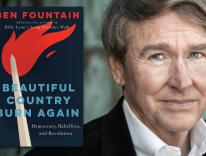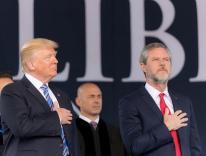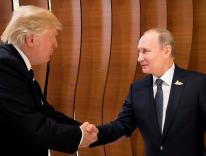One week from the election, polls show that the worst case scenario is still possible. No, not a Trump presidency. The worst case scenario is: Clinton winning the presidency through the electoral college, Trump winning the popular vote, and Trump not conceding the election. I don’t mean the kind of not conceding that Gore initially did, when the votes in one state required a recount. I mean the kind of not conceding where Trump loses many swing states, with no credible fraud, but still won’t concede, perhaps up to and through January, leading to unpredictable civic unrest and likely violence. In a country with more guns than people, this is the worst case scenario.
What will happen if Trump “keeps us in suspense” on election night, as he promised at the last debate? And after this election, even if he does concede, what will be the civic glue that holds America together?
In his recent book, The End of White Christian America, Robert P. Jones depicts white Protestantism as a kind of “civic glue” for most of our country’s history. With its decline both in numbers and intensity of affiliation, Jones wonders what will replace it for America’s future. Whether Jones is right or not about the role religion has played, certainly something must be the glue that holds a diverse society together—especially after such a polarizing season.
Yesterday I discussed the topic with a group of smart, well-informed millennials (my students). Since our country doesn’t share common kinship or common descent, and we are rapidly losing a sense of a majority’s religiosity, our brainstorming focused on a few other possibilities for what unites America.
One proposal is a common history from which to draw our symbols and narratives. While some aspects of our recent history are credibly described as common—the defeat of the Nazis, the pride in the space program, the Cold War with the U.S.S.R., our nationwide mourning after September 11, shared admiration for most aspects of the civil rights movement—there are too many conflicting narratives for most major events of our history. The fragmentations of perspectives on symbols like Columbus Day, or on the Black Lives Matter movement, or on our constant military operations in the Middle East pose a significant challenge for the forging of a common history. The proliferation of media exacerbates the challenge, even while it enables—for the better—the propagation of narratives from those marginalized in our society.
History and cultural anthropology demonstrate that a nationalism based on a common enemy can also act as a civic glue. This fact was memorably satirized by The Onion in 1998 with the cover story, “State Department To Hold Enemy Tryouts Next Week.” While the satire mostly skewered the “military-industrial complex,” it also noted the struggles of Hollywood to find compelling enemies, such as the Russians in Top Gun. And a fictional psychotherapist lamented that Americans had been “forced to find other outlets for their deepest insecurities and fears,” including “sexuality and our own government.” Great satire always relies on a partial truth, and indeed moral psychologist Jonathan Haidt includes “Loss of a Common Enemy” after the Cold War as one of the explanations for increased political polarization in our country. But even if it were wise to select a common enemy for the purposes of nationalism, it is difficult, if not impossible, to unite a country against one that is neither clearly identifiable nor bounded. Loosely organized terrorism generates fear and a short-term binding effect, but that’s nothing remotely like the long-term nationalism necessitated by the Cold War.
Thinking more positively about a civic glue, another candidate for “common enemy” is climate change. Young people are very attuned to this reality, as each passing month and year is warmer than the last and industrialization rises in India and China. In a hopeful version of the future, a national solidarity could emerge in fighting this problem. Doing so would draw on another aspect of our civic glue, which is a widespread ideology of scientific progress and even belief in technological salvation. Though Pope Francis writes against a “technocratic paradigm” for humanity in relation to nature, a kind of national effort (akin to the space race) could potentially bolster Americans' bonds to one another while fighting a different kind of war.
We discussed other (less grand) ideas and rituals that cut across boundaries of class and race to authentically, if fleetingly, unite Americans. We are a relentlessly consumerist country, for example, chasing trends and technological updates. We are an endlessly creative country, whose innovations in the arts and music frequently bring together people of different walks of life. And our near-constant American sporting events—from local soccer leagues up to the full slate of professional sports—are some of the most diverse gatherings on earth and, for all their faults, do offer real opportunities for human encounters outside of one’s socioeconomic group.
Finally, I asked the students to reflect on the core American political ideologies as reflected, for example, on our coinage. What is the story that we tell ourselves about ourselves? The tokens of political ideology jingling in our pockets bear three phrases that capture the American spirit: Liberty, e pluribus unum, and In God We Trust. Whatever way forward we find will rely on these principles at the heart of American civic education, enshrined in our calendar and passed on in our schools. Can we be a country that balances liberty and religiosity? Can we become a country that forges unity-in-diversity, through a pervasive belief that doing so is, in and of itself, a firm basis for national identity? Can we do so while telling the truth about our failings and refusing to vilify our fellow citizens?
On the face of it, the phrase “In God We Trust” carries the religious resonance. But the phrase “e pluribus unum” is, at heart, the American prayer. And as civil religion fades, the doctrine of unity-in-diversity may be what holds us together.
Please email comments to [email protected] and join the conversation on our Facebook page.
Share
Previous Story
The Enemy Within
Next Story
Michael Hollerich Replies to C. C. Pecknold


